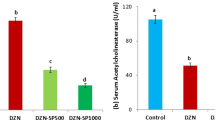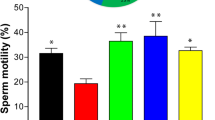Abstract
Arsenic (As) toxicity through induction of oxidative stress is a well-known mechanism of organ toxicity. To address this problem, buffalo epiphyseal proteins (BEP, at 100 μg/kg BW, i.p. for 28 days) were administered intraperitoneally to female Wistar rats exposed to As (100 ppm sodium arsenite via drinking water for 28 days). Arsenic exposure resulted in marked elevation in lipid peroxidation in brain, cardiac, and hepatic tissues, whereas significant (p < 0.05) adverse change in catalase, superoxide dismutase, glutathione reductase, glutathione peroxidase, and reduced glutathione level were observed in cardiac, hepatic, and brain tissues of As-administered animals. BEP significantly (p < 0.05) counteracted all the adverse changes in antioxidant defense system brought about by As administration. Based on these results, we consider BEP as a potent antioxidant to be used for protection from arsenic-induced oxidative stress related damage of vital organs.

Similar content being viewed by others
References
Tchounwou PB, Wilson BA, Ishaque A (1999) Important considerations in the development of public health advisories for arsenic and arsenic containing compounds in drinking water. Rev Env Health 14:1–19
Yamanaka K, Katsumata K, Ikuma K, Hasegawa A, Nakano M, Okada S (2000) The role of orally administered dimethylarsinic acid, a main metabolite of inorganic arsenics, in the promotion and progression of UVB-induced skin tumorigenesis in hairless mice. Cancer Lett 152:79–85
Bhadauria S, Flora SJS (2007) Response of arsenic-induced oxidative stress, DNA damage, and metal imbalance to combined administration of DMSA and monoisoamyl-DMSA during chronic arsenic poisoning in rats. Cell Biol Toxicol 23:91–104
Xi S, Guo L, Qi R, Sun W, Jin Y, Sun G (2010) Prenatal and early life arsenic exposure induced oxidative damage and altered activities and mRNA expressions of neurotransmitter metabolic enzymes in offspring rat brain. J Biochem Mol Toxicol 24:368–378. doi:10:1002/jbt
Lynn SJ, Gurr R, Lai HT, Jan KY (2000) NADH oxidase activation is involved in arsenite-induced oxidative DNA damage in human vascular smooth muscle cells. Circ Res 86:514–519
Liu J, Liu YP, Goyer RA, Achanzar W, Waalkes MP (2000) Metallothionein-I/II null mice are more sensitive than wild-type to hepatotoxic and nephrotoxic effects of chronic oral or injected inorganic arsenicals. Toxicol Sci 55:460–467
Liu SX, Athar M, Lippai I, Waldren C, Hei TK (2001) Induction of oxyradicals by arsenic: implication for mechanism of genotoxicity. Proc Natl Acad Sci 98:1643–1648
Bharti VK, Srivastava RS (2009) Protective role of buffalo pineal proteins on arsenic-induced oxidative stress in blood and kidney of rats. Health 1:167–172
Halliwell B (1989) Oxidative stress and neurodegeneration: where are we known. J Neurochem 97:1634–1658
Halliwell B, Gutteridge JM (1992) Free radicals, antioxidants, and human disease: where are we now. J Lab Clin Med 119:598–620
Sachidanandam K, Fagan SC, Ergul A (2005) Oxidative stress and cardiovascular disease: antioxidants and unresolved issues. Cardiovasc Drug Rev 23:115–132
Bharti VK, Srivastava RS (2009) Fluoride-induced oxidative stress in rat’s brain and its amelioration by buffalo (Bubalus bubalis) pineal proteins and melatonin. Biol Trace Elem Res 130:131–140
Bharti VK, Srivastava RS (2009) Pineal proteins up-regulate specific antioxidant defense systems in the brain. Oxid Med Cell Longev 2:88–92
Bharti VK, Srivastava RS (2011) Effect of pineal proteins at different dose level on fluoride-induced changes in plasma biochemicals and blood antioxidants enzymes in rats. Biol Trace Elem Res 141:275–282
Bharti VK, Srivastava RS, Anand AK, Kusum K (2011) Buffalo (Bubalus bubalis) epiphyseal proteins give protection from arsenic and fluoride-induced adverse changes in acetylcholinesterase activity in rats. J Biochem Mol Toxicol. doi:10.1002/jbt.20407
Bethesda MD (1985) Guide for the care and use of laboratory animals. National Institute of Health, Public Health Service. DHEW Publication no: NIH 80-23
Rehman S (1984) Lead-induced regional lipid peroxidation in brain. Toxicol Lett 21:333–337
Sedlak J, Lindsay RH (1968) Estimation of total, protein-bound, and nonprotein sulfhydryl groups in tissue with Ellman’s reagent. Analyt Biochem 25:192–205
Bergmayer HU (1983) UV method of catalase assay. In: Grassi M, Bergmeyer J (eds) Methods in enzymatic analysis. VCH, Weinheim, p 273
Madesh M, Balasubramanian KA (1998) Microtitre plate assay for superoxide dismutase using MTT reduction by superoxide. Indian J Biochem Bioph 35:184–188
Paglia DE, Valentine WN (1967) Studies on the quantitative and qualitative characterization of erythrocyte glutathione peroxidase. J Lab Clin Med 70:158–169
Goldberg DM, Spooner RJ (1983) Glutathione reductase. In: Grassi M, Bergmeyer J (eds) Methods in enzymatic analysis. VCH, Weinheim, pp 258–265
Lowry OH, Rosebrough NJ, Farr AI, Randall RJ (1951) Protein measurement with the Folin phenol reagent. J Biol Chem 193:265–275
Modi M, Mittal M, Flora SJS (2007) Combined administration of selenium and meso-2, 3-dimercaptosuccinic acid on arsenic mobilization and tissue oxidative stress in chronic arsenic-exposed male rats. Indian J Pharmacol 39:107–114
Halliwell B, Gutteridge JMC (2006) Free radicals in biology and medicine, 4th edn. Oxford University Press, Oxford
Garcia-Chavez E, Santamaria A, Diaz-Barriga F, Mandeville P, Juarez BI, Jimenez-Capdeville ME (2003) Arsenite-induced formation of hydroxyl radical in the striatum of awake rats. Brain Res 976:82–89
Garcia-Chavez E, Jimenez I, Segura B, DelRazo LM (2006) Lipid oxidative damage and distribution of inorganic arsenic and its metabolites in the rat nervous system after arsenite exposure: influence of alpha tocopherol supplementation. Neurotoxicology 27:1024–1031
Das S, Santra A, Lahiri S, Guha Mazumder DN (2005) Implications of oxidative stress and hepatic cytokine (TNFalpha and IL-6) response in the pathogenesis of hepatic collagenesis in chronic arsenic toxicity. Toxicol Appl Pharm 204:18–26
Flora SJS (1999) Arsenic-induced oxidative stress and its reversibility following combined administration of N-acetylcysteine and meso 2, 3-dimercaptosuccinic acid in rats. Clin Exp Pharmacol Physiol 26:865–869
Bharti VK, Srivastava RS (2010) Effects of epiphyseal proteins and melatonin on the blood biochemical parameters of fluoride-intoxicated rats. Neurophysiology 42:309–315
Sejian V (2006) Studies on pineal–adrenal relationship in goats (Capra hircus) under thermal stress. PhD thesis, Indian Veterinary Research Institute, Izatnagar
Simonneaux V, Ribelayga C (2003) Generation of the melatonin endocrine message in mammals: a review of the complex regulation of melatonin synthesis by norepinephrine, peptides, and other pineal transmitters. Pharmacol Rev 55:325–395
Bharti VK, Srivastava RS, Subramaian P, Spence DW, Pandi-Perumal SR, Brown GM (2011) Cerebral epiphyseal proteins and melatonin modulate the hepatic andrenal antioxidant defense of rats. Int J Nephrology. Article ID 142896. doi:10.4061/2011/142896
Acknowledgement
Research grant and facilities provided by Indian Veterinary Research Institute (IVRI) for conducting this study is duly acknowledged. We also acknowledge the tireless efforts of our lab and animal-shed assistants.
Conflict of Interest
All the authors declare that there are no conflicts of interest.
Author information
Authors and Affiliations
Corresponding author
Rights and permissions
About this article
Cite this article
Bharti, V.K., Srivastava, R.S., Sharma, B. et al. Buffalo (Bubalus bubalis) Epiphyseal Proteins Counteract Arsenic-Induced Oxidative Stress in Brain, Heart, and Liver of Female Rats. Biol Trace Elem Res 146, 224–229 (2012). https://doi.org/10.1007/s12011-011-9245-0
Received:
Accepted:
Published:
Issue Date:
DOI: https://doi.org/10.1007/s12011-011-9245-0




